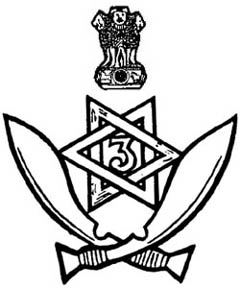 Kafar Bhanda Marnu Ramro(It is better to die in Valour than to live like a Coward)
Kafar Bhanda Marnu Ramro(It is better to die in Valour than to live like a Coward)
4th Battalion ( Nawang’s Battalion)
The 3 Gorkha Rifles is one of the most celebrated regiments of the Indian Army with an unblemished record of battle honours and courage since its establishment on April 24, 1815 as a Kumaon Battalion. In 1907, the Regiment was re-designated as 3rd Queen Alexandra’s Own Gorkha Rifles. During the First World War, the Regiment distinguished itself in France, Gaza & Palestine and won 18 battle honours. During the Second World War, the Regiment fought in Burma, Malaya, Java, Indonesia, Iraq, Persia, Palestine, North Africa & Cyprus and again proved its mettle.
Post Independence, the Regiment won the Battle Honour ‘Pir Kanthi’ in the Uri Sector in 1948 and ‘Shingo-R’ in the Kargil Sector in 1971. The 1/3 Gorkha Rifles has the distinction of being the first battalion in the post-independence period to carry out amphibious operations during the 1971 Indo-Pak War. Colonel J.R. Chitnis, CO 1/3 GR, was honoured with the Ashok Chakra posthumously – India’s highest peacetime medal for valour – in Nagaland in 1956.
The Indian Army has a large Cantonment area in the holy city of Varanasi (or Benaras, or Kashi). This Cantonment, established in the last century, is the training Centre for the 3rd and 9th Gorkha Regiments and hence known in the army terms as 39 Gorkha Training Centre (39 G T C). it is a huge complex, most beautifully kept and efficiently managed.(Read about our visit to 39 GTC)
Nawang belonged to the 4th Battalion of the 3rd Gorkha Rifles Raising of the 4th Battalion). The battalion is the smallest fighting unit in the Army. A regiment is made up of many battalions. The Battalion, which is know amongst the Army as the “Palton” has the strongest bonds with an officer. This is his family and the men there are their brothers.(Read about our visit to the Palton)
Regimental Centre :
Varanasi, Uttar Pradesh.
Insignia :
A pair of crossed khukris (a Gorkha dagger), with a star in-between and the numeral three within.
Motto :
(It is better to die in Valour than to live like a Coward)
War Cry
Ayo Gorkhali(The Gorkhas Are Here).
Regimental Battalions
……………………………………..1st Battalion
…………………………………….2nd Battalion
……………………………………3rd Battalion
…………………………………….4th Battalion ( Nawang’s Battalion)
…………………………………….5th Battalion
Post-Independence
Battle Honours Pir Kanthi and Shingo R.
Honours & Awards 1 Ashok Chakra, 1 Kirti Chakra, 5 Vir Chakra, 5 Shaurya Chakra, 1 Yudh Seva Medal, 19 Sena Medals, 1 Bar to Sena Medal, 4 Param Vishist Seva Medals, 5 Ati Vishist Seva Medals, 9 Vishist Seva Medals, 2 McGregor Medals, 26 Mentioned-in-Despatches, 46 COAS’ Commendation Cards and 19 GOC-in-C’s Commendation Cards.
Linage
Raised at Almora (Kumaon) on 24 April 1815 by Lt Sir Robert Colquhoun
1815: The Kemaoon Battalion
1816:The Kemaoon Provincial Battalion
1823: 9th ( Kemaoon) Local Battalion
1826: 7th ( Kemaoon) Local Battalion
1850: The Kemaoon Battalion
1861: 18th Regiment, Bengal Native Infantry
1861: 3rd Goorkha ( The Kemaoon) Regiment
1864: 3rd (The Kumaon) Goorkha Regiment
1887: 3rd Goorkha Regiment
1891: 3rd Gurkha ( Rifle) Regiment
1901: 3rd Gurkha Rifles.
1907: 3rd The Queen’s Own Gurkha Rifles.
1908: 3rd Queen Alexandra’s Own Gurkha Rifles.
1949: 3rd Queen Alexandra’s Own Gorkha Rifles.
1950: 3rd Gorkha Rifles
The founder Lt. Sir Robert Colquhoun, was a Scotsman, and his family tartan is that adopted by the regiment , and worn by their pipe band.


